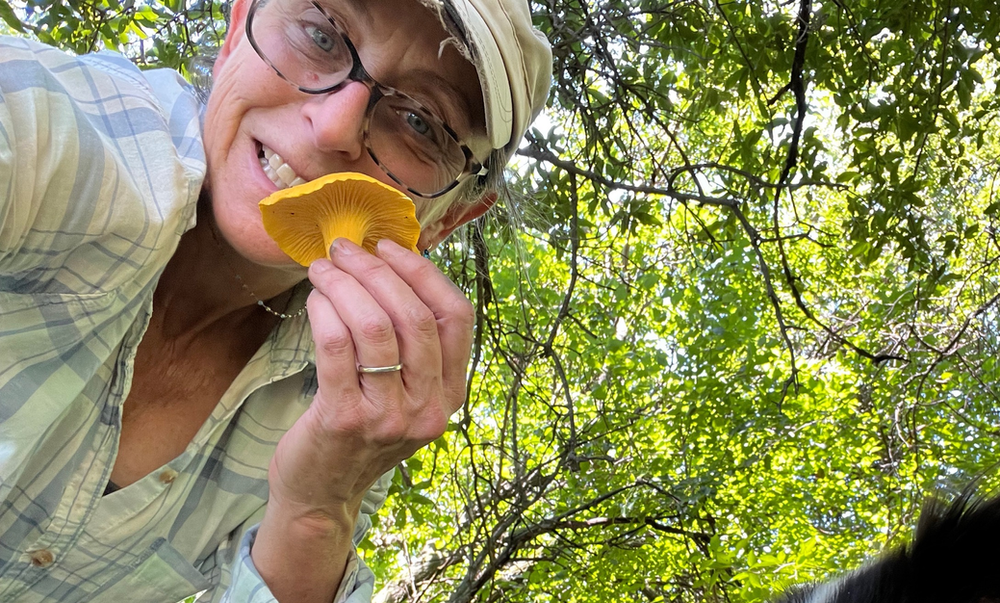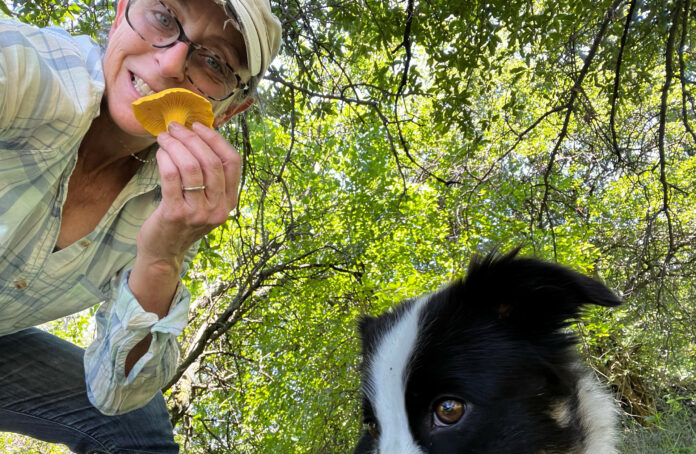
“Farm Meditations” are a series of short stories based on events that happen on Whippoorwill Creek Farm in South Central Iowa. We raise grass fed and finished beef, goats, foraged mushrooms and some veggies. We will also soon have farm stays and space for small events! Please get in touch with us for sales and to book your stay with us this fall.You can read other meditations in the series and subscribe to them by clicking here. My stepson Antonio used to laugh at John and I when we said we were going mushroom hunting. “How can you hunt something that stands still?” he’d ask. He had a point. Mushrooms are about as sedentary and non-stealth-like as Mother Nature gets. They are often even flashy and colorful, making them—one would think—stand out like an orange in a case of apples. Stealthy chanterelles on the forest floorAnd yet wild mushrooms are much like an elephant grazing out on the African plains—beautiful creatures with the ability to hide in plain sight, almost invisible if you are not actually looking for them (or with the case of elephants, they don’t move). Yet once you turn your awareness to their existence, once you recalibrate your focus to see the amazing beings right in front of your face, suddenly you can see them clearly.This happens to us all the time in our daily lives. You learn a word, and then, poof! It is everywhere. You focus on how dirty your house is and you are bound to see only dust; you can choose to notice the kindness in strangers and it will be everywhere if you are looking for it. You can even read about an event in history, and suddenly your perspective of the world shifts and you can understand its relevance to everything. So I headed out on my mushroom “hunt” to look for chanterelles—an elusive and delicious bright orange mushroom that covers the forest floor like specks of gold when it is out. I was hoping to find a few to sell to restaurants in Des Moines, and knew from past years just where to look, in one of my favorite areas on the farm—the “riparian zone.”The “riparian zone” is in quotations because, while it is actually a riparian zone (a creek and its surrounding ecosystem), it was called “the ditch” until quite recently. “The ditch” was a place where generations of Hogeland threw things—everything from household trash to dead farm equipment—creating what I like to refer to as “a heap of shit.” The heap is rather well contained in one small area of the ditch, a place especially easy to drive a tractor and toss a radiator or hog feeder into it. But it struck to me as soon as we moved to the farm and I could see garbage in several of these ditches: does calling a place a “ditch” allow us to treat it badly? Does the disrespectful sounding name have anything to do with the garbage thrown into it?I get it that there was a time not so long ago when trash pick up was not a thing. John’s great, great grandparents and even parents didn’t have much choice when it came to getting rid of their garbage, even if that trash was an old harvester. At the time long ago, much of a household’s waste was biodegradable—seed sacks in canvas, food scraps, paper bags. But by the time Leroy (John’s dad) inherited the farm, household trash was full of plastic, and there was a whole lot more farm equipment to toss out when it quickly became obsolete as the next new thing in agriculture arrived.When we took over the farm a five years ago, we started to clean up the ditches. John’s sister Andrea, her son Lucas, John and I would spend hours hauling stuff out of creek bottoms with the tractor, filling entire trailers full of metal scraps for the recycler and garbage bags destined for the landfill. And as part of the renovation of the creek bottom and its surrounding area, I asked that it also be called something different, something that might instill more respect and inspire people to treat it better than a “ditch.” “Riparian zone” is what I came up with, and although it is a mouthful and the words don’t exactly roll off the tongue, at least the area sounds a bit more scientifically important and even high class. It insists you look at the area as part of an ecosystem and to treat it in a different way.So there I was in the riparian zone, looking for chanterelles, my eyes slowly attuning to the world around me in a new and different way. And poof! Like that, there they were, all around me. I saw one chantrelle, then many, the clusters of mushroom-gold everywhere. And not only were there chantrelles, there were mushrooms of all kinds, even ones I had never seen before. Snooks and I excited about chanterellesThe point of this meditation, then is two fold; two separate yet dependent concepts. The first is something I forget all the time, namely that if I just take the time to adjust my eyes and focus, I can learn to see what is often there right in front of my very own eyes. This act in and of itself changes the world around me, often from one I see in a negative light to one that is full of awe and grace.But then the second part of the meditation is equally as important; once we see the world differently, we need to recast it in our brains. If I see an area teeming with chanterelles and other life forms, it transforms from a ditch to a riparian zone. If I turn my gaze to see the kindness of strangers, it is no longer a world full only of hate and despair and I can change the way I think and talk about it with others. And if I learn more about history and how it has been unkind to so many, I can incorporate other perspectives into the telling of our collective story.I hope this meditation is helpful for you this Saturday morning (or whenever you are reading). Let me know your thoughts about it, and if you have any questions about the farm.
Right in Front of My Face
